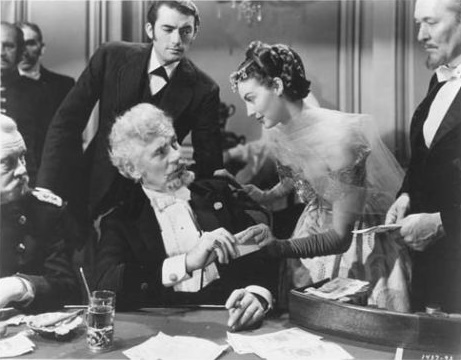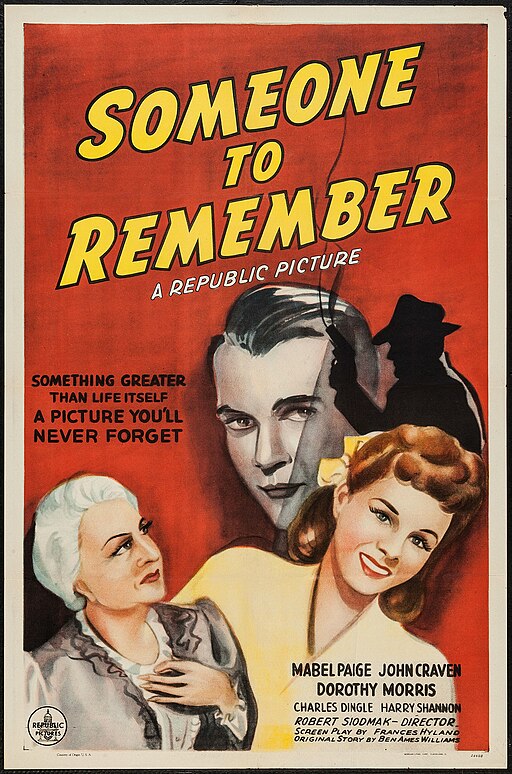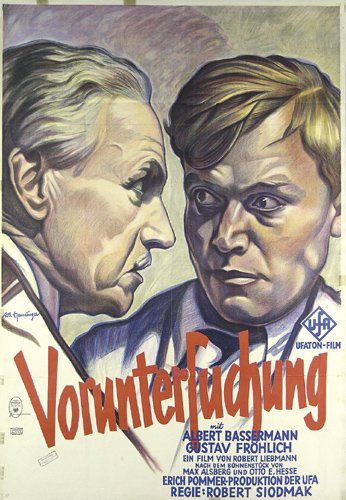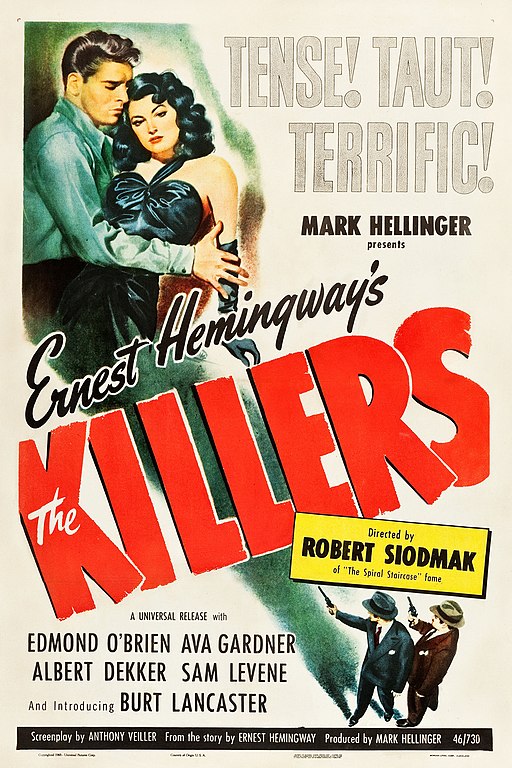Robert Siodmak
back| Full Name | Robert Siodmak |
| Born | August 8, 1900 |
| Birthplace | Dresden, Germany |
| Died | March 10, 1973 |
| Buried | Cimetière du Montparnasse, Paris, France |
| Married to | Bertha Odenheimer (married 1933–1973, his death) |
| Children | Not publicly known |
| Notable films | The Killers - Criss Cross - Phantom Lady - The Spiral Staircase |
Robert Siodmak – “Master of Shadow and Suspense”
Robert Siodmak was a German film director known for his influential work in the film noir genre. Born on August 8, 1900, in Dresden, Germany, he began his film career in the silent era of the Weimar Republic and quickly gained a reputation for his visual style. Fleeing the rise of the Nazi regime, Siodmak emigrated to Paris and later to Hollywood, where he made a significant mark with his noir films in the 1940s.
In Hollywood, Siodmak's talent for moody, shadow-laden drama came to the fore. His best-known works include "The Spiral Staircase" (1946) and "The Killers" (1946), which earned him an Academy Award nomination for Best Director. His films often explored themes of fate and existential angst, making him a defining figure in noir cinema.
Despite a career that waned in the 1950s, Siodmak left an indelible legacy with his atmospheric storytelling and meticulous craftsmanship. His influence is seen in the works of many directors who followed, and his best films remain classics of their genre. Siodmak passed away on March 10, 1973, in Locarno, Switzerland, but his contributions to cinema continue to be celebrated.
Related
Robert Siodmak
Biography, analysis of his direction style and all his movies
Robert Siodmak was a prominent film director known for his work in film noir during the 1940s. Born in Dresden, Germany, he started his filmmaking career in the burgeoning film industry of 1920s Berlin, but the rise of the Nazi regime pushed him to move to Paris and later to Hollywood.
In the United States, he established himself with a string of suspenseful thrillers and film noirs that displayed his characteristic visual style and complex narratives. Siodmak was adept at creating high-tension atmospheres and rich character development. His films often explored themes of fate, guilt, and existential angst.
"The Killers," adapted from an Ernest Hemingway short story, was among his most celebrated works, launching Burt Lancaster's career and receiving critical acclaim. "Criss Cross" with its intricate heist plot and "The Spiral Staircase," a gothic thriller, further cemented his reputation as a master of the noir genre.
Siodmak's work was characterized by expressive lighting, inventive camera angles, and a strong use of shadow and light to convey psychological complexity. His contributions to the film noir style have influenced many directors and are studied by film scholars to this day.
Analysis of Robert Siodmak’s direction style:
Robert Siodmak is often lauded for his distinctive directing style, particularly within the film noir genre, which he helped to shape in the 1940s. His direction style can be analyzed through several key characteristics:
Visual Style
Siodmak's films are known for their high-contrast lighting, employing shadows and light to create a moody and atmospheric visual aesthetic that has become synonymous with film noir. His use of chiaroscuro lighting techniques helped to enhance the psychological tension and the moral ambiguity of the characters.
Camera Work
Siodmak frequently used complex camera movements to build suspense and engage the audience. He often employed tracking shots, crane shots, and dolly-ins to reveal important story elements or to draw the viewer closer to the characters' emotional states.
Tense Atmospheres
Siodmak excelled at creating tense, suspenseful atmospheres that kept audiences on edge. His films often feature a creeping sense of dread, partly achieved through the combination of his visual style and the use of music and sound design to underscore the tension.
Storytelling
Narratively, his films often focused on characters trapped by circumstances beyond their control, exploring themes such as fatalism, obsession, and betrayal. He was adept at crafting complex, tightly woven narratives that often featured flashbacks or non-linear storytelling to gradually reveal the plot.
Characterization
Siodmak's characters are typically well-developed, with complex motivations and backstories. He had a talent for eliciting nuanced performances from his actors, often highlighting their inner turmoil and conflict, making the characters as important as the plot.
Symbolism
His work is also noted for its use of visual metaphors and symbolism, using physical elements within the scene to reflect the internal state of the characters or the broader themes of the narrative.
Genre Blending
While known for film noir, Siodmak didn't limit himself strictly to this genre. He was known to blend elements from other genres such as gothic horror, as seen in "The Spiral Staircase," and psychological thrillers, which added depth and variety to his body of work.
European Influence
Having started his career in Germany and then France, Siodmak brought with him to Hollywood a European sensibility that informed his storytelling and visual approach, distinguishing his films from those of his contemporaries.
Siodmak's style influenced subsequent generations of filmmakers, especially those working within the thriller and noir genres. His ability to create a palpable tension, both visually and narratively, is a hallmark of his enduring legacy in cinema.
Notable movies directed by Robert Siodmak:
- Menschen am Sonntag (1930): A silent film that follows a group of residents of Berlin during a weekend.
- Brennendes Geheimnis (1933): A drama about a boy who feels neglected when his mother starts a flirtation with a stranger on a holiday.
- Phantom Lady (1944): A noir thriller about a secretary who sets out to prove her boss's innocence after he's accused of murder.
- The Suspect (1944): In Victorian London, a kind shopkeeper is driven to murder his shrewish wife and must stay one step ahead of a Scotland Yard inspector.
- The Strange Affair of Uncle Harry (1945): A fabric designer in a small town is unhappily unmarried and cares for his manipulative, invalid sister.
- The Spiral Staircase (1946): A mute servant is terrorized in a gloomy mansion by a murderer who is targeting disabled women.
- The Killers (1946): Based on Ernest Hemingway's story, two hit men kill an ex-boxer in a small town, and an insurance investigator uncovers a complex web of deceit.
- Cry of the City (1948): A police detective and a gangster are childhood friends and their relationship complicates when they find themselves on opposite sides of the law.
- Criss Cross (1949): A man tricks his workplace into planning a heist of an armored car but his plan goes awry when he becomes involved with his ex-wife who is now the girlfriend of the gang's leader.
- The File on Thelma Jordon (1950): An assistant district attorney gets romantically involved with a woman who is suspected of murdering her wealthy aunt.
- Deported (1950): A deported gangster's plan to re-enter the USA involves skulduggery at a safe haven for aged, destitute ex-cons.
- The Whistle at Eaton Falls (1951): A film about labor management disputes in post-war America, centering on a labor leader who finds himself caught in the middle of a murder cover-up.
- The Crimson Pirate (1952): A swashbuckling adventure about a pirate who tries to overthrow a Caribbean island, but his plans are complicated by the arrival of a beautiful rebel.
- The Great Sinner (1949): A man becomes addicted to gambling and falls in love with a woman also addicted while studying a gambling ring.
- Scandal at Scourie (1953): After a childless Canadian couple adopts a girl from an orphanage in the Catholic part of Quebec, the husband's fishery business is threatened.
- The Rats (1955): In post-war Berlin, an American private helps a lost Czech boy to find his mother.
- The Rough and the Smooth (1959): A woman seduces a playboy archaeologist. When he falls in love with her, he finds out she's a prostitute.
- Escape from East Berlin (1962): Based on a true story, residents of East Berlin find a way to escape to the West.
Remarkable quote from Robert Siodmak:
"A film is like a battleground. It's love, hate, action, violence, death... In one word: emotion."
Awards and Nominations:
Robert Siodmak, a notable director especially during the classic film noir era, had a career that spanned both Europe and Hollywood. Despite his influence on the genre, his recognition in terms of awards was not extensive, especially when compared to the more prominent awards today. Here’s an overview of his major awards and nominations:
Academy Awards (Oscars):
-
Nominated in 1946 for Best Director for "The Killers", which was one of his most celebrated films.
Venice Film Festival:
- In 1947, his film "The Killers" was entered into the Venice Film Festival.
Berlin International Film Festival:
- His film "The Rats" won the Golden Bear in 1955.
Other Honors:
- While not an award per se, Siodmak's films, particularly his noirs, have been later recognized and celebrated in retrospectives and by film critics and historians.
It's worth noting that during Siodmak's prime, there were fewer festivals and awards than there are today, and many of his genre films were not the type that traditionally garnered awards attention at the time.
Nonetheless, his legacy is well-regarded, and his influence on film noir is significant. His skill in creating suspense and his distinctive visual style have earned him a respected place in film history, even if that didn't translate into a long list of awards during his lifetime.
Full list of movies directed by Robert Siodmak:
- People on Sunday (1929)
- Farewell (1930)
- The Man in Search of His Murderer (1931)
- Quick (1932)
- Brennendes Geheimnis (1933)
- The Crisis is Over (1934)
- La vie parisienne (1936)
- Cargaison blanche (1937)
- Mollenard (1938)
- West Point Widow (1941)
- Fly-by-Night (1942)
- My Heart Belongs to Daddy (1942)
- The Night Before the Divorce (1942)
- Someone to Remember (1943)
- Son of Dracula (1943)
- Phantom Lady (1944)
- Cobra Woman (1944)
- The Suspect (1944)
- Christmas Holiday (1944)
- The Strange Affair of Uncle Harry (1945)
- The Spiral Staircase (1946)
- The Killers (1946)
- Time Out of Mind (1947)
- Cry of the City (1948)
- Criss Cross (1949)
- The Great Sinner (1949)
- The File on Thelma Jordon (1950)
- Deported (1950)
- The Whistle at Eaton Falls (1951)
- The Crimson Pirate (1952)
- The Golden Blade (1953)
- Scandal at Scourie (1953)
- Passion (1954)
- Die Ratten (1955)
- Mein Vater, der Schauspieler (1956)
- Nachts, wenn der Teufel kam (1957)
- Dorothea Angermann (1959)
- The Rough and the Smooth (1959)
- Mein Schulfreund (1960)
- The Nina B. Affair (1961)
- Escape from East Berlin (1962)
- The Condemned of Altona (1962)
- Custer of the West (1967)





